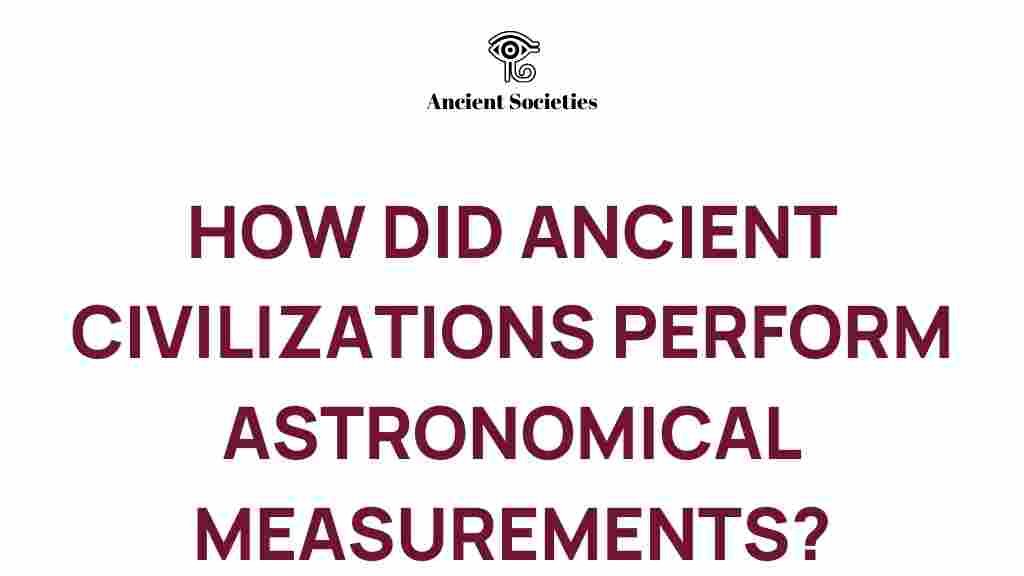How Ancient Civilizations Mastered the Art of Astronomical Measurements
The study of astronomy has fascinated humans for millennia. Ancient civilizations around the globe developed sophisticated methods for astronomical measurements that not only enhanced their understanding of the cosmos but also played a crucial role in their daily lives. From timekeeping to navigation, these cultures utilized celestial observation to forge their identities and shape their histories. In this article, we will explore how various ancient civilizations mastered the art of astronomical measurements, the technologies they employed, and the cultural significance of their celestial observations.
The Importance of Astronomy in Ancient Civilizations
Astronomy was more than just a scientific endeavor for ancient cultures; it was deeply intertwined with their religion, agriculture, and societal organization. The ability to predict celestial events allowed these civilizations to:
- Guide agricultural practices: Understanding the cycles of the moon and stars helped in determining the optimal times for planting and harvesting crops.
- Enhance navigation: Mariners relied on the stars to navigate the seas, ensuring safe travel and trade.
- Establish calendars: Accurate timekeeping was essential for religious ceremonies and social organization.
- Understand the cosmos: The desire to comprehend the universe and humanity’s place within it drove many ancient cultures to develop complex astronomical models.
Technological Innovations in Astronomy
Different ancient civilizations developed unique technologies for astronomical measurements. Here are some notable examples:
1. The Sumerians
The Sumerians, one of the earliest known civilizations, made significant contributions to astronomy. They created:
- Base-60 system: This system is the foundation of our modern timekeeping, where an hour is divided into 60 minutes and a minute into 60 seconds.
- Celestial charts: Sumerians recorded the positions of stars and planets, which helped in predicting celestial events.
2. The Egyptians
The ancient Egyptians used astronomy for practical purposes, including:
- Pyramids alignments: The Great Pyramids are aligned with incredible precision to the cardinal points, reflecting the Egyptians’ understanding of the stars.
- Solar calendar: They developed a 365-day solar calendar based on the heliacal rising of Sirius, which signaled the flooding of the Nile.
3. The Babylonians
The Babylonians took astronomical measurements to new heights with their advanced mathematical techniques. They were known for:
- Astronomical records: They meticulously recorded the movements of celestial bodies, leading to the development of predictive astronomy.
- Sexagesimal system: Their base-60 numeral system has influenced modern measurements in angles and time.
4. The Greeks
The ancient Greeks made profound contributions to astronomy, including:
- Geocentric model: Figures like Aristotle and Ptolemy proposed models that placed the Earth at the center of the universe.
- Instruments: They developed tools like the astrolabe and armillary sphere for celestial observation and navigation.
5. The Mayans
The Mayans were exceptional astronomers who created:
- Complex calendars: Their Long Count calendar was used to track longer periods of time, reflecting their understanding of celestial cycles.
- Observatories: Structures like El Caracol were used for precise astronomical observations.
Step-by-Step Process of Astronomical Measurements in Ancient Civilizations
To understand how these ancient civilizations made their astronomical measurements, we can break down their processes into several key steps:
1. Observation
Celestial observation was the first step in astronomical measurements. Ancient cultures would watch the night sky for:
- Patterns in star movement
- The phases of the moon
- Planetary alignments
2. Recording
After observations, the next step involved meticulous recording. Ancient astronomers would:
- Keep logs of celestial events
- Develop constellations and star charts
- Utilize various forms of writing, such as cuneiform or hieroglyphics, to document their findings
3. Calculation
With data in hand, ancient civilizations would perform calculations. This involved:
- Using mathematical systems to predict future events
- Creating algorithms to estimate positions of celestial bodies
- Employing geometry for more accurate measurements
4. Application
The final step was applying their astronomical knowledge to real-world scenarios, including:
- Developing agricultural calendars
- Guiding navigation for trade and exploration
- Planning religious festivals and civic events
Troubleshooting Common Issues in Celestial Observation
1. Obscured Visibility
Cloudy skies or obstacles (like mountains) could obstruct views of celestial bodies. Solutions included:
- Utilizing higher vantage points for better observation.
- Establishing multiple observation points to compare data.
2. Inaccurate Record Keeping
Inaccuracies in recording could lead to errors in predictions. To mitigate this, civilizations would:
- Implement rigorous training for astronomers.
- Cross-check observations with other astronomers.
3. Technological Limitations
Without advanced tools, measurements could be imprecise. Solutions involved:
- Innovating new measurement tools like gnomons for shadow measurements.
- Improving mathematical techniques to refine calculations.
The Cultural Significance of Astronomy
Astronomy was not only a scientific pursuit but also held significant cultural importance. It influenced:
- Religion: Many cultures worshipped celestial bodies as gods or incorporated them into their mythologies.
- Art and Architecture: Celestial patterns influenced art, architecture, and city planning.
- Social Structure: The roles of priests and astronomers often held high status due to their knowledge of celestial events.
Conclusion: The Legacy of Ancient Astronomy
The mastery of astronomical measurements by ancient civilizations laid the groundwork for modern science and technology. Their ability to observe, record, and predict celestial events highlights the ingenuity of human cultures throughout history. Today, we continue to benefit from their discoveries as we explore the universe and develop new technologies for celestial observation.
Understanding the history of astronomy not only enriches our appreciation for these ancient cultures but also inspires us to look up and wonder about the cosmos. As we advance our technology and deepen our understanding of the universe, we pay homage to the ancient civilizations that first dared to gaze at the stars.
For more information on the contributions of ancient cultures to astronomy, you may visit NASA’s educational resources.
To learn about modern astronomical technologies and their applications, check out this insightful article.
This article is in the category History and created by AncientSocieties Team
